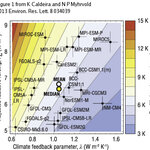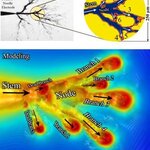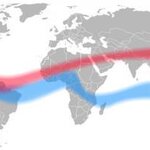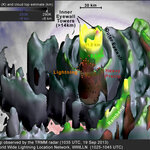Atmospheric

Clouds on Mars look a lot like those on Earth: images of the Martian sky taken by NASA's Opportunity rover depict gauzy, high-altitude wisps, similar to our cirrus clouds.
These clouds likely consist of either carbon dioxide or water-based ice crystals but since we can't sample a Martian cloud yet, it's difficult to know the precise conditions that give rise to them. So researchers have done the next-best thing; they've recreated Mars-like conditions within a three-story-tall cloud chamber in Germany, adjusting the chamber's temperature and relative humidity to match conditions on Mars —…

This page is a rewrite of the page that was here a few days ago, I had some issues with getting the sign of the data right. The values are the same, only the direction of the change in minimum temperature changed. I apologize for any confusion this may have created. As soon as I can get the upload to work I intend to upload all of my sql code used to process this data for inquiring minds and anyone who'd like to duplicate this work.
There are many different ways surface temperature records have been examined, all of which require taking some liberties with the actual data. The approach taken…

The mystery of why life on Earth evolved has gotten more complicated, not less.
Scientists in a new paper say they have ruled out a theory as to why the planet was warm enough to sustain the planet's earliest life forms when the Sun's energy was roughly three-quarters the strength it is today.
Life evolved on Earth during the Archean, between 3.8 and 2.4 billion years ago, but the weak Sun should have meant the planet was too cold for life to take hold at this time; scientists have therefore been trying to find an explanation for this conundrum, what is dubbed the 'faint, young Sun paradox…

Most research has focused on the amount of global warming resulting from increased greenhouse gas concentrations but there has been relatively little study of the pace of the change following these increases.
A new paper concludes that about half of the warming occurs within the first 10 years after an instantaneous step increase in atmospheric CO2 concentration, but about one-quarter of the warming occurs more than a century after the step increase. The authors used results from the majority of the world's leading climate models - over 50 climate simulations, which were performed using 20…

Streamers may be great for decorating a child's party, but in dielectrics they are the primary origin of electric breakdown and can cause catastrophic damage to electrical equipment, harm the surrounding environment, and lead to large-scale power outages.
Understanding streamers and the mechanisms behind their initiation, acceleration and branching is necessary to devise better solutions to avoid them. A team of researchers at MIT have developed an accurate 3-D model of streamer propagation that qualitatively and quantitatively describes the streamer development, an advance that…

An estimate finds that a northward shift of Earth's wind and rain belts could make a broad swath of regions drier, including the Middle East, American West and Amazonia, while making Monsoon Asia and equatorial Africa wetter.
The authors based their prediction on knowledge of warming that brought Earth out of the last ice age about 15,000 years ago and climate data collected from around the world, from tree-rings, polar ice cores, cave formations, and lake and ocean sediments. Based on that, they hypothesize that the wind and rain belts shifted north from about 14,600 years ago to 12,700…

Super Typhoon Usagi and its 150 MPH winds will be the strongest weather event this year.
The radar on the Tropical Rainfall Measuring Mission (TRMM) satellite captured an image of Supertyphoon Usagi near the end of a 24-hour period in which Usagi intensified by 65 knots. This is more than twice the commonly used 30-knot threshold for defining rapid intensification. The TRMM data was used to create a 3-D image. The data was collected at 1035 UTC/6:35 a.m. EDT on Thursday, September 19, 2013, when Usagi was at category 3 on the Saffir-Simpson hurricane intensity scale.
A few hours later…

Observational satellite data and a computer model have predicted response to human influence have a common latitude/altitude pattern of atmospheric temperature change.
The key features of this pattern are global-scale tropospheric warming and stratospheric cooling over the 34-year satellite temperature record.
The troposphere is the lowest portion of Earth's atmosphere. The stratosphere lies above the troposphere.
A new report compared multiple satellite records of atmospheric temperature change with results from a large, multi-model archive of simulations. Fingerprint information has…

Atmospheric levels of carbon monoxide (CO) in the 1950s were actually slightly higher than what we have today, according to a first-ever study of air trapped in the deep snowpack of Greenland - results that contradict current computer model predictions that there are much higher CO concentrations over Greenland today than in 1950.
In a new paper, Vasilii Petrenko, an assistant professor of earth and environmental sciences, concluded that CO levels rose slightly from 1950 until the 1970s, then declined strongly to present-day values. This finding contradicts computer models that had…

20 years ago, El Niño had an uncorrected impact on the data that went into global warming models, causing puzzling results. Now, those results have been corrected and instead of El Niño impacting global warming, global warming could be impacting El Niño.
Using coral samples from Kiribati, researchers have outlined how El Niño Southern Oscillation (ENSO) cycle has changed over the past 4,300 years - altering the cycles of El Niño and La Niña events that bring extreme drought and flooding to Australia and many other Pacific-rim countries. The new paper suggests that external changes…